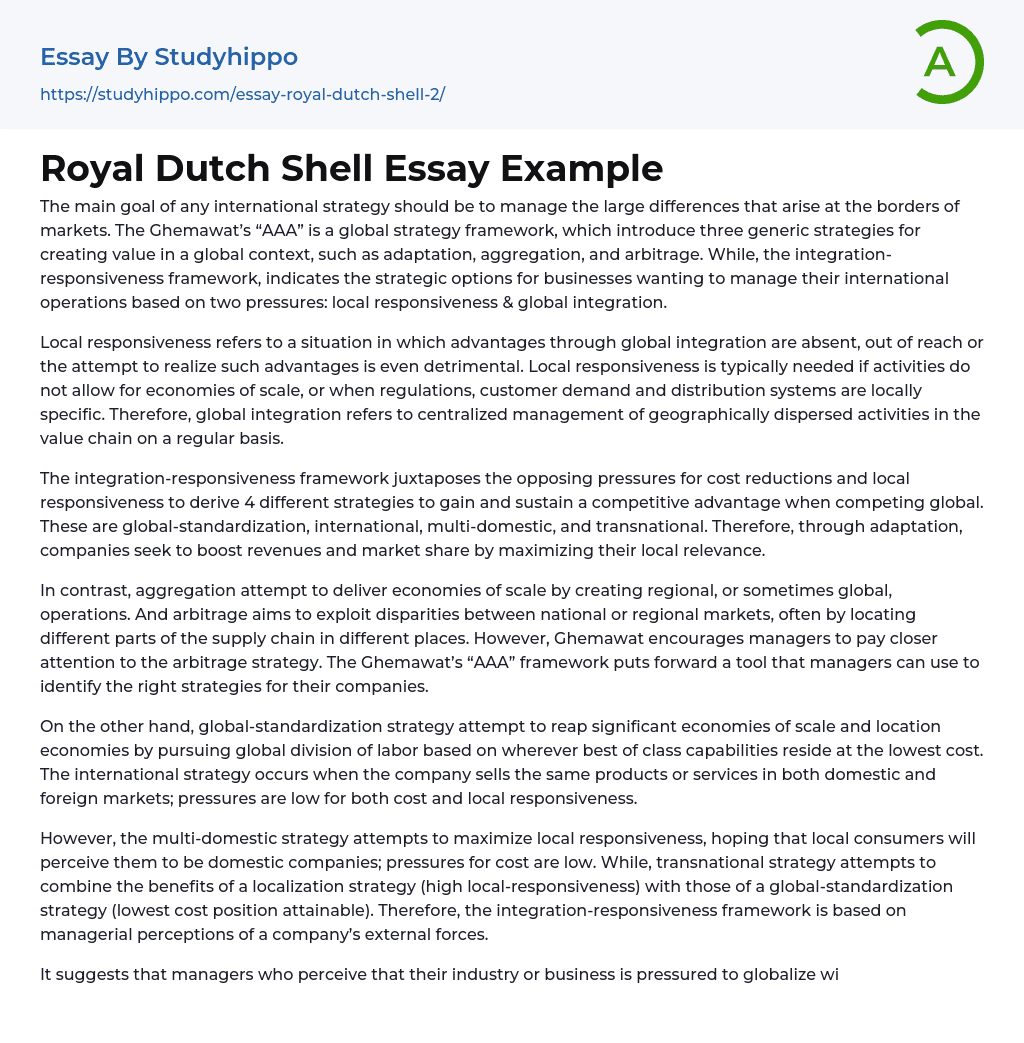The main goal of any international strategy should be to manage the large differences that arise at the borders of markets. The Ghemawat’s “AAA” is a global strategy framework, which introduce three generic strategies for creating value in a global context, such as adaptation, aggregation, and arbitrage. While, the integration-responsiveness framework, indicates the strategic options for businesses wanting to manage their international operations based on two pressures: local responsiveness & global integration.
Local responsiveness refers to a situation in which advantages through global integration are absent, out of reach or the attempt to realize such advantages is even detrimental. Local responsiveness is typically needed if activities do not allow for economies of scale, or when regulations, customer demand and distribution systems are locally specific. Therefore, global integration refers to centralized management of geographically dispersed activities in the value chain on a regular basis.
...The integration-responsiveness framework juxtaposes the opposing pressures for cost reductions and local responsiveness to derive 4 different strategies to gain and sustain a competitive advantage when competing global. These are global-standardization, international, multi-domestic, and transnational. Therefore, through adaptation, companies seek to boost revenues and market share by maximizing their local relevance.
In contrast, aggregation attempt to deliver economies of scale by creating regional, or sometimes global, operations. And arbitrage aims to exploit disparities between national or regional markets, often by locating different parts of the supply chain in different places. However, Ghemawat encourages managers to pay closer attention to the arbitrage strategy. The Ghemawat’s “AAA” framework puts forward a tool that managers can use to identify the right strategies for their companies.
On the other hand, global-standardization strategy attempt to reap significant economies of scale an
location economies by pursuing global division of labor based on wherever best of class capabilities reside at the lowest cost. The international strategy occurs when the company sells the same products or services in both domestic and foreign markets; pressures are low for both cost and local responsiveness.
However, the multi-domestic strategy attempts to maximize local responsiveness, hoping that local consumers will perceive them to be domestic companies; pressures for cost are low. While, transnational strategy attempts to combine the benefits of a localization strategy (high local-responsiveness) with those of a global-standardization strategy (lowest cost position attainable). Therefore, the integration-responsiveness framework is based on managerial perceptions of a company’s external forces.
It suggests that managers who perceive that their industry or business is pressured to globalize will maximize the central coordination and integration of activities across national boundaries. In contrast to the integration-responsiveness framework, which indicates the preferred organizational approach based on the external globalization or localization forces; The “AAA” framework suggests measuring the internal pressures that a company faces, specifically advertising, R&D and labor. Therefore, the AAA model answers the conflicting forces for integration and responsiveness.
In compare, arbitrage, one of the Ghemawat’s dimension, which intends to exploit differences between countries, often by establishing different parts of the value chain in different locations; the transnational strategy, one of the integration-responsiveness framework, had already included all of it in their description, but it had fused into one dimension with local responsiveness. Therefore, it seems that the integration-responsiveness framework its better, because it encompass the external forces of a company.
- Auction essays
- Balanced Scorecard essays
- Business Plans essays
- Expense essays
- Income essays
- Net Income essays
- Security Guard essays
- Singapore Airlines essays
- Battle essays
- Intranet essays
- Maintenance essays
- Simulation essays
- Inn essays
- Chief Executive Officer essays
- Convenience Store essays
- Firm essays
- Training And Development essays
- Unilever essays
- Variable Cost essays
- Virgin Group essays
- Bargaining essays
- Entity essays
- Pest analysis essays
- Email essays
- Hypertext Transfer Protocol essays
- Marshall Mcluhan essays
- Virtual Learning Environment essays
- Web Search essays
- Etiquette essays
- Mainstream essays
- Vodafone essays
- Web Search Engine essays
- Advertising essays
- Audience Theory essays
- Competitor Analysis essays
- Consumer essays
- Marketing Management essays
- Marketing Mix essays
- Marketing Plan essays
- Marketing Research essays
- Marketing Strategy essays
- Point Of Sale essays
- Price essays
- Procurement essays
- Product essays
- Product Differentiation essays
- Promotion essays
- Promotion And Marketing Communications essays
- Retailing essays
- Trademark essays




